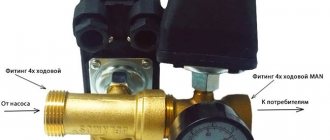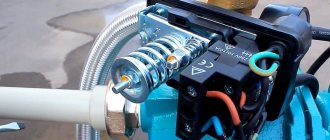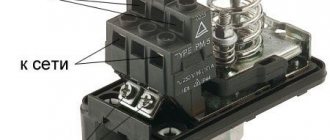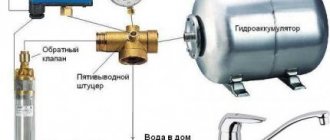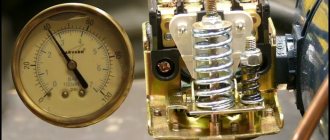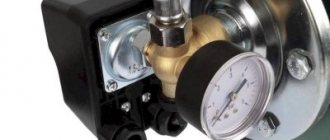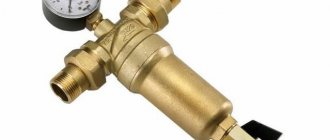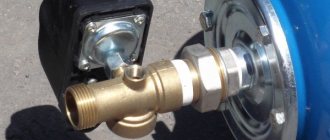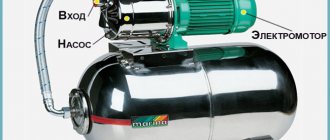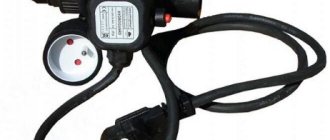Primary indicators
The block is immediately hung on the pump.
For a submersible pump you need to choose it yourself. But in any case, the block is already adjusted during manufacture. Many of them have the following start and stop settings: 1.5 - 3.0 atmospheres . But some models may have smaller values.
The lower start limit is at least 1.0 bar, the upper stop limit is 1.2 - 1.5 bar more. In the instructions for the station, the lower start-up setting may be designated as P, or PH.
This value may vary. The difference between the lower and upper response limits can be designated as ΔP (deltaP). This indicator is also regulated.
When does automation need to be reconfigured?
There are various reasons why a pump may not deliver the required value. Let's briefly list the most common ones:
- the equipment operates at a large suction depth and cannot achieve the required water supply;
- wear of the pump impeller, cannot drive water to the required force;
- increased wear of sealing seals, air leaks;
- the need to supply water with high pressure to a multi-story building or a highly located storage tank;
- mechanisms that consume water require more pressure.
In these and other similar cases, you will need to change the factory settings.
Common faults
Article on the topic: Water pressure regulator in a water supply system : what it is, design and principle of operation, types, how installation is performed, review of models, average prices, useful tips and recommendations - read our review.
The most common cause of breakdowns of pumping stations is a lack of water in the system. The load that appears when there is a lack of water causes the pump to fail in a very short time. In order not to spend money on constantly replacing pumps, you should immediately buy a good relay model and not worry about this cause of failure.
Why is there no fluid in the system?
The main reason for this problem is the large volume of liquid consumption when the volume of the well or reservoir is simply not enough. In the summer, problems often occur that cause interruptions in water delivery. Drought or pipe repairs can cause an unexpected loss of water supply.
The most unpleasant cause is an accident at a pumping station. In this case, you will have to change the pump and all related parts, and at the same time the house will be left without water supply for some period of time.
Corrosion can cause failure of pumping equipment
It is to protect against these unpleasant situations that a water pressure switch for a pump with protection against dry running was invented. This function of the device is capable of opening the contacts and completely turning off the pump. The pump motor will only turn on again when the water flow returns to normal. The indicator, which includes protection against dry running, is set at the factory during manufacture. Most often it is 0.5 atm. This number cannot be changed.
Electrical diagram for connecting the dry running sensor
In addition, manufacturers offer a flow switch that combines its functions with a pressure switch. This version of the device is also capable of ensuring correct operation of the water supply system.
Note! During adjustment work, you should definitely pay attention to the power specified by the manufacturer. The station should not be adjusted to a pressure that it cannot withstand, according to the manufacturer.
Preparation for the process
Before making adjustments, you should eliminate possible problems that could disrupt the operation of the pumping station. And also carry out routine maintenance measures for the pump and storage tank.
You should check the tightness of the suction pipe, replace worn oil seals, stuffing box packing, and plumbing windings on threaded connections. In favorable conditions, it will be easier for the pump to achieve the desired pressure.
Check the air pressure in the air chamber of the expander . It should be inflated with the same pressure or 10% lower than that set to start the pump. If the lower pressure changes during regulation, then inflate taking into account the new value.
It is necessary to pump air into the expander when there is no pressure in the water supply. To do this, turn off the power to the pump and drain the water through any valve. Without closing the valve, check with what force the air is pumped into the expander and pump it taking into account the new value. When air is added, some water will flow out of the water supply - this is acceptable. You can pump it up with any car pump.
After performing maintenance on the station and adjusting the air pressure in the expander, you can proceed to readjusting the adjustments.
Connecting the water pressure switch
Step-by-step installation of a pressure switch in the water supply system.
It is simultaneously connected to the power supply and water consumption, and is intended for permanent connection. Before you start connecting the pressure switch, understand the details.
Electrical part
Separate electrical wiring is desirable - it gives a better chance of increasing service life. You will need a single-core copper cable with a cross-section of 2.5 square mm. It is recommended to install a machine and an RCD in a complex. The main characteristics are selected based on the current consumed by the pump, because the relay itself does not require much electricity.
It is important to provide a grounding connection, because the device is installed on a water pipe and may pose a potential danger.
The pressure switch device for the pumping station is equipped with:
- phase and neutral connectors from the power source;
- the same contacts from the pumping station;
- The grounding is connected to the same wiring from the power source and the station that sets the pressure.
All wires are firmly fixed in accordance with standard connection requirements. After an hour, the contacts should be checked and tightened when
necessity.
Connecting to the water supply yourself
There are various schemes for connecting the relay to the water supply:
- for convenience, a special device with a fitting for five terminals is used;
- various fittings are used;
- It is recommended to equip the water supply with filters that ensure long service life.
The result is high-quality water supply with the same pressure. It allows you to use a variety of plumbing fixtures.
What characteristics should be changed?
A simple control unit has two variable characteristics:
- The first, pump start pressure (P), is the lower limit at which the pump starts.
- The second is the delta (ΔP) pressure between the start point and the upper cutoff at which the pump stops.
It is worth noting a feature of all mechanical relays. If you adjust the lower start limit, the upper limit will also adjust by the same amount. Here is an example, at 1.5 atmospheres of start and 3.0 stops, increasing the pump starting force to 2.0 atm, the upper cut-off will increase to 3.5 atm.
However, when adjusting the delta (ΔР), setting the pump shut-off pressure, the pump starting force will remain the same.
Example: at 1.5 atm. and 3.0 atm., ΔР equals 1.5 atm. By reducing ΔР to 1.0 atm, the upper cutoff will become 2.5 atm. The launch point will remain the same, 1.5 atm.
Knowing this feature of the relay, when rebuilding the upper cutoff of the pump, it is enough to adjust ΔР , that is, perform 1 alteration.
But when you adjust the lower start pressure limit, the upper stop cutoff will change. It may also need to be adjusted. That is, you need to perform 2 settings.
When changing the settings, you should know that the pump cutoff should be 0.3 - 0.5 bar lower than the maximum pressure level that the pump can create. This pressure level must be written in the manual (instructions) for the pump.
For example, with a maximum pressure of 55 meters that the pump can reach, the cutoff should be no higher than 5.0 - 5.2 bar . Otherwise, the pump will work for a long time without turning off, trying to reach the maximum set level. This will lead to premature wear and increased energy consumption.
The ΔP value affects another parameter - how often the pump will turn on. The higher the delta, the less frequently the pump will start and the longer it will last.
But you shouldn’t set too big a difference either, otherwise the pump will pump longer, after the water flow stops, until it can raise the pressure to the set level. In addition, using tap water at high pressure is not convenient.
Below is a table for possible situations that require adjusting the regulator and which springs should be readjusted:
| Situation | Adjustable points | Rework option |
| The pump runs for a long time without stopping | The upper pump stop cut-off should be changed. | 1st: lower ΔP (the starting point will remain the same), the pump will turn on more often 2nd: lower P, the cutoff will also decrease |
| Water flows weakly from the tap | The start pressure should be increased and the cut-out pressure should be maintained. | Compress spring P, weaken spring ΔP, returning to its previous value |
| Increase overall pressure | The cut-in pressure should be increased | Compress spring P, the cutoff will also become higher, you may need to reduce it |
| Reduce overall pressure | The starting pressure should be reduced | Loosen spring P, the upper cutoff will also decrease |
| The pump starts often, you need to do it less often | The cut-out pressure should be increased | Compress the spring ΔР, without exceeding the maximum pressure (95% of the pump pressure) |
Purpose and design of the pressure switch
Important: there is no point in installing a pressure switch if the system does not have a hydraulic accumulator or pump. Also, during installation, you need to know that the relay is placed behind the pump and in front of the storage accumulator. Sometimes it is installed on the pump itself, including a submersible one.
Pressure switch device
I propose to consider the purpose of the elements and the method of operation of the system. A hydraulic accumulator is a container that is equally divided by a special partition. One half is inflated with air, the other with water.
Their proportions are 1/1. Increasing the volume of air increases the pressure. It all depends on the principle of their operation. Increasing the functionality of the home water supply - the pressure is calculated at 1.4-2.8 atm.
Adjusting the relay allows you to set the limits of the restrictions. When it drops below the lower limit, the pump turns on, when it rises, it turns off. As a result, the pressure remains within the specified limits.
This includes parts with electrical and hydraulic components.
Let's look at how this relay works:
- The first component includes a set of components that start and stop pumping equipment.
- Hydraulic - has a special partition that exerts pressure on a solid partition, as well as two springs of different sizes.
- As a result, the pumping equipment is turned on and off.
As a result of the interaction of this mechanism, the pressure does not exceed the specified limits, which increases the comfort of living in the house.
Varieties
There are two types of water pump relays: mechanical and electronic devices. Let's look at their features:
- Mechanical devices are mainly used; they are more reliable and less expensive. Mechanical - located in a durable housing, which contains the following parts: piston, elastic partition, metal platform, contact unit.
Under the protective housing cover there are two springs of different sizes. When the membrane is triggered, it pushes the piston, which acts on the springs, resulting in the pump being turned on or off.
- Electronic devices are more accurate. They have a sensor that turns off the pump if there is no water. Such products have a higher cost and are installed to order. The use of such equipment requires modern plumbing, which has great functionality.
The most common option is electromechanical sensor models, which are convenient to use. They are distinguished by their reliability, which protects the water supply system from unexpected changes in pressure.
How to configure the block correctly?
To adjust the block you will need:
- a flat-head screwdriver for unscrewing the cover,
- open-end wrench or 8 mm socket.
Before starting work, you need to check the existing start and stop pressure of the pump using a pressure gauge installed together in the block.
If the pressure gauge is not working properly or is missing, you should connect a control pressure gauge to the water supply, with a measurement range from 0 to 6 atm, in increments of 0.1 or 0.2.
First, the plastic cover of the control unit is unscrewed .
Under it, on the block platform, there will be two springs: a large one and a small one. A large spring regulates the pressure at which the contacts close and the pump starts. Often, next to the spring, the letter P is stamped on the metal . Using a smaller spiral, the difference in pressure between starting and stopping the pump is adjusted. May have a ΔР symbol next to it.
How to reconfigure a block:
- Identify the actual moments of starting and stopping the pump using a pressure gauge.
- Decide what new torques should be set, determine whether the difference ΔP between the starting and stopping torques needs to be maintained.
- If the starting moment does not change, then reconfigure the small spiral ΔP. If the start pressure needs to be changed, then the resetting begins with the large spring P, and then proceeds to adjusting the small spring.
- To increase the force of water, the nut rotates in the direction of the arrow on the clock, the spiral contracts. To lower, turn the nut counterclockwise, the spiral will loosen.
- After 1 - 2 turns of the nut, you should start the pump to find out the new moments when the unit starts and stops.
- When the required starting torque is obtained, the pump proceeds to changing the cut-off torque by rotating the small spiral nut. Clockwise rotation, compressing the spiral, leads to a larger range of ΔР, counterclockwise, weakening the spiral, leads to a smaller range of ΔР.
- After 1 - 2 full turns of the nut, a test run of the pump is made again to determine new torques.
- When setting the required moments, you should also make sure that the pump turns off within 5 seconds when the upper cut-off torque is reached, with all valves closed.
How to regulate in a private house?
Adjusting the unit installed in an apartment is no different from the settings in a private house . But in a private house, the start-up and shutdown times are often set higher than in an apartment.
This may be due to the presence of a second floor, equipment on a personal plot that requires higher pressure.
Consequences of not making the necessary adjustments
If the pump operates within the range of modes recommended by the instructions, then there will be no serious consequences for it . Users may only experience some inconvenience due to too high or low pressure.
If the station operates outside the established recommendations, for example, does not turn off for a long time or is turned on very often, in this case the station experiences increased loads, which will lead to premature wear of the impeller and the electrical part of the installation. The pump will not last long and will break prematurely.
